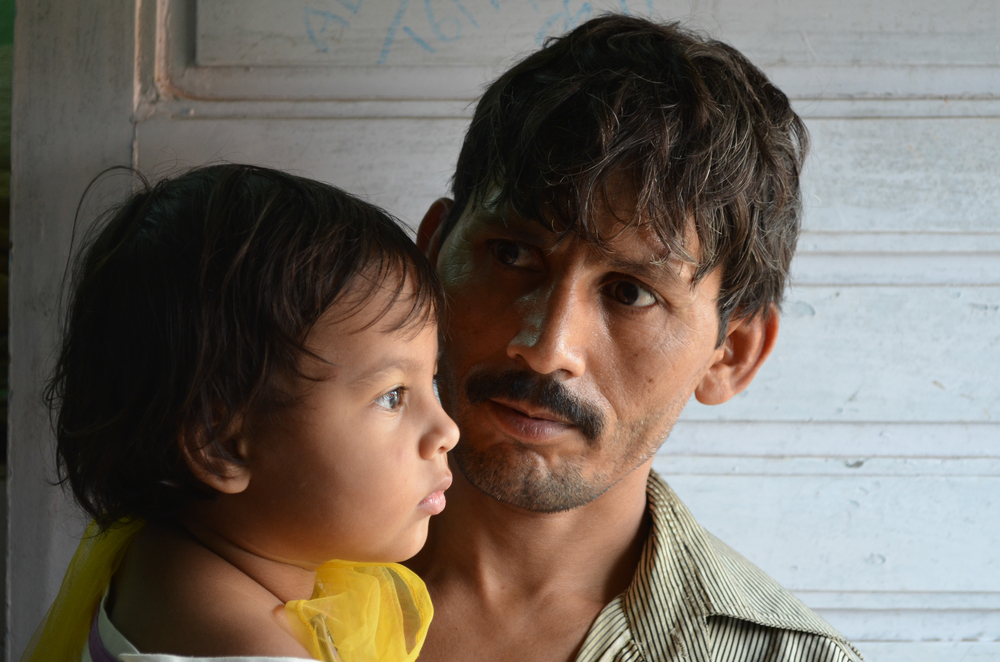
Yvdalmia/Shutterstock
.
If there’s one thing that really, really upsets America’s child welfare establishment, it’s pointing out the close resemblance between the Trump administration’s so-called “zero tolerance” policy that separated children from their parents at the Mexican border and the American foster care system.
So, every few weeks, it seems, there is another desperate attempt at hair-splitting to try to convince us that when American child protective services agencies tear apart families nearly 270,000 times every year, it’s nothing like those roughly 2,600 cases that occurred on the border.

Richard Wexler
Of course the two systems are not identical. Although the percentage is small, some of the children taken by U.S. agencies really did need to be removed for their own safety. And unlike Donald J. Trump, most people in the U.S. child welfare system have good intentions.
But even the good intentions can have a downside. They are likely to shield needless removal of children into U.S. foster care system from the kind of intensive scrutiny the Trump family separation policy is likely to get when Democrats take control of the House of Representatives in January.
That’s unfortunate, because good intentions is pretty much where the differences end. As this handy chart makes clear, everything else amounts to distinctions without differences. And the efforts of foster care apologists to draw those distinctions actually illustrate the extent to which the two systems are similar.
So Cathy Senderling-McDonald, deputy executive director of the California County Welfare Directors Association, tells us that in the system she works for:
“There are required court hearings, with court-appointed lawyers, that begin no later than two court days after a child is removed from their parents. A petition must be filed at that time or the child is returned to the parents. Abuse and neglect on the part of the parents must be substantiated in court for the child to be in our system.”
And Professor Richard Gelles tells us:
“Placement into foster care requires due process including court hearings and evidence, and the parents often are afforded counsel to protect their rights (the provision of counsel varies from state to state).”
All of that is grossly misleading.
IN CHILD WELFARE, DUE PROCESS IS A SHAM
For starters, child protective services workers can and do take away children without a court hearing first. All they have to do is declare it an emergency and they either can remove the children on the spot themselves or call law enforcement to do it for them. In New York City, for example, which shows more restraint than most places when it comes to taking away children, roughly half of all removals approved by judges at the first hearing involve cases in which the children already had been taken away, entirely on the child welfare agency’s own authority.
The court hearings in these cases come after the fact. Two “court days” can mean four or five calendar days, and in many states the delay is even longer. Even what adults might see as a very short stay in foster care is long enough to traumatize a small child. And the very fact that the child was removed before that first hearing further stacks the deck against families at every step in the process.
Gelles himself acknowledges that families don’t always get lawyers. Even when families do get a lawyer, it’s almost always a grossly overworked public defender or “panel attorney” who just met her or his client five minutes before the hearing. A serious defense is almost impossible.
As for the notion that abuse needs to be “substantiated” to hold a child in foster care, the standard for that is not “beyond a reasonable doubt” as in criminal trials, or even the middle standard of proof in legal proceedings, “clear and convincing.” In most states the child welfare agency need merely show that it is slightly more likely than not that maltreatment occurred. This “preponderance of the evidence” standard is the same one used to decide which insurance company pays for a fender bender.
Presiding over all this is a judge who knows that if he allows one child to go home and something goes wrong his career may well be over. Rubber-stamp the agency over and over and hold the children in foster care, even if the agency has not made a good case, and those children will suffer terribly — but the judge is safe. Sometimes, judges even admit to doing just that.
And one more thing: In most states, all the court hearings are secret.
So here’s my question for Gelles, Senderling-McDonald, et al: Would this kind of due process be good enough for your family? If a loved one got in trouble with the law, would you say: “Don’t worry, just accept a public defender who has no real time for your case and go to a court that can convict you based on an incredibly low standard of proof in a secret trial. That’s all the due process you need!”
The real difference between the Trump family separation policy and the foster care system is one has no due process and the other has sham due process.
A NEWFOUND RESPECT FOR ‘REASONABLE EFFORTS’?
Gelles argues that another distinction between the two systems is that “child welfare agencies are required by law to make reasonable efforts to keep children with their parents.” But everyone in child welfare knows that law is not enforced.
In Alaska, the director of the child welfare agency has admitted they don’t do it; in Massachusetts the whole idea of reasonable efforts is treated with contempt, and in Michigan 40 percent of judges admitted that they lied and said the state child welfare agency made “reasonable efforts” in cases where the judges really didn’t believe it. (Without such a finding, the case is ineligible for federal foster care aid.) In October, the special assistant to one of the federal government’s top child welfare officials condemned the failure of states to make reasonable efforts.
And even this widely ignored, unenforced law actually is too much for Richard Gelles. He is on record seeking to get rid of it entirely.
In 1996, in an article for the conservative Weekly Standard, called “Two Words That Kill,” Gelles wrote:
“What if, by changing two words in a federal law, you could prevent the deaths of hundreds of children each year and also prevent tens or even hundreds of thousands of abused children from being victimized again and again? It is time to replace the words ‘reasonable efforts’ with two others: Child safety.”
Among other things, Gelles said, this change might encourage more use of orphanages — and he thinks that’s a good idea.
So not only is the U.S. foster care system more like the Trump policy than Richard Gelles wants to admit, if Gelles achieves his ultimate goal, the systems will be even more similar.
NUMBERS GAMES
Gelles insists the two systems are different because while the Trump administration used a broad brush, hardly anyone is placed in foster care. Said Gelles:
“In cases where the referral [alleging abuse or neglect] was substantiated, only one-quarter of the children are placed outside their home.”
First of all, it’s actually more like 40 percent (676,000 so-called “substantiated” cases, often meaning only that a caseworker guessed it was slightly more likely or not that a case fit a broad, vague definition of abuse or neglect, 269,690 entries into care — and that figure doesn’t include all the removals states don’t report to the federal government).
But more important, in the past Gelles himself has rightly rejected the notion of minimizing a problem because it supposedly doesn’t harm “enough” children. In that same Weekly Standard article he wrote: “Advocates will also argue that child welfare policy should not be based on child fatalities because such fatalities are rare. Well, child fatalities are not rare enough.”
He’s right about “not rare enough.” The only acceptable number for child abuse fatalities is zero. But that’s also the only acceptable number for how often children are traumatized by needless removal from their homes.
And consider again the sheer number of times the U.S. foster care system inflicts this trauma — more than 269,000. That’s over 100 times more than the number of children affected by the Trump policy. If a figure that huge is still a small percentage of anything in child welfare it shows only the extent to which the entire child welfare system is out of control.
CHILD WELFARE’S VERSION OF ‘DEPORTATION’
Meanwhile, Senderling-McDonald argues that under the Trump policy:
“Parents are deported to their home countries without their children, who are legal citizens of those countries, returned to them as they leave. The children are kept in legal limbo, in unknown circumstances.”
But in this respect the U.S. system sometimes is worse. It’s the children who end up “deported” — shipped all over the country to sometimes abusive institutions — as documented most recently by Disability Rights Washington. In one case documented by DRW, a child was sent from Washington state to South Carolina — that’s farther than the distance from parts of the Mexican border to Central America.
Senderling-McDonald goes on to say the foster care system is not a place “where the children are pulled away from their parents and placed into warehouses with thin blankets, chain link fences and only each other for comfort.”
Right. Instead, they’re pulled away from their parents, placed in institutions rife with abuse and doped up on potent, sometimes dangerous psychiatric medication — with only each other for comfort. And horrible as the conditions were for the children at the border, the foster care system of which Senderling-McDonald is so proud often inflicts this abuse on a child for far longer.
Senderling-McDonald also tells us that everything the foster care system does is in the best interests of the child. “That guiding principle is followed at every step of the process,” she says. Were that true, the system would have paid attention to the mass of research showing that, in the typical cases seen by CPS workers, children fare better left in their own homes even than comparably maltreated children placed in foster care.
But even if one accepts that the intent of foster care is to serve children’s best interests, that doesn’t change the results. Those horrible results are the biggest thing the two systems have in common — and that is what the foster care apologists are desperate for the rest of us to ignore.
This short documentary, from The Atlantic shows what even a separation of “only” one month can do to a young child. And here’s what happened to a child who was separated not by the Border Patrol but by well-meaning child protective services workers in Minnesota. The tears are the same, the trauma is the same.
That’s why good intentions are not enough. That’s why what happened on the border has been a wake-up call for many Americans. And that’s why the foster care apologists would rather we all went back to sleep.
Richard Wexler is executive director of the National Coalition for Child Protection Reform.


























